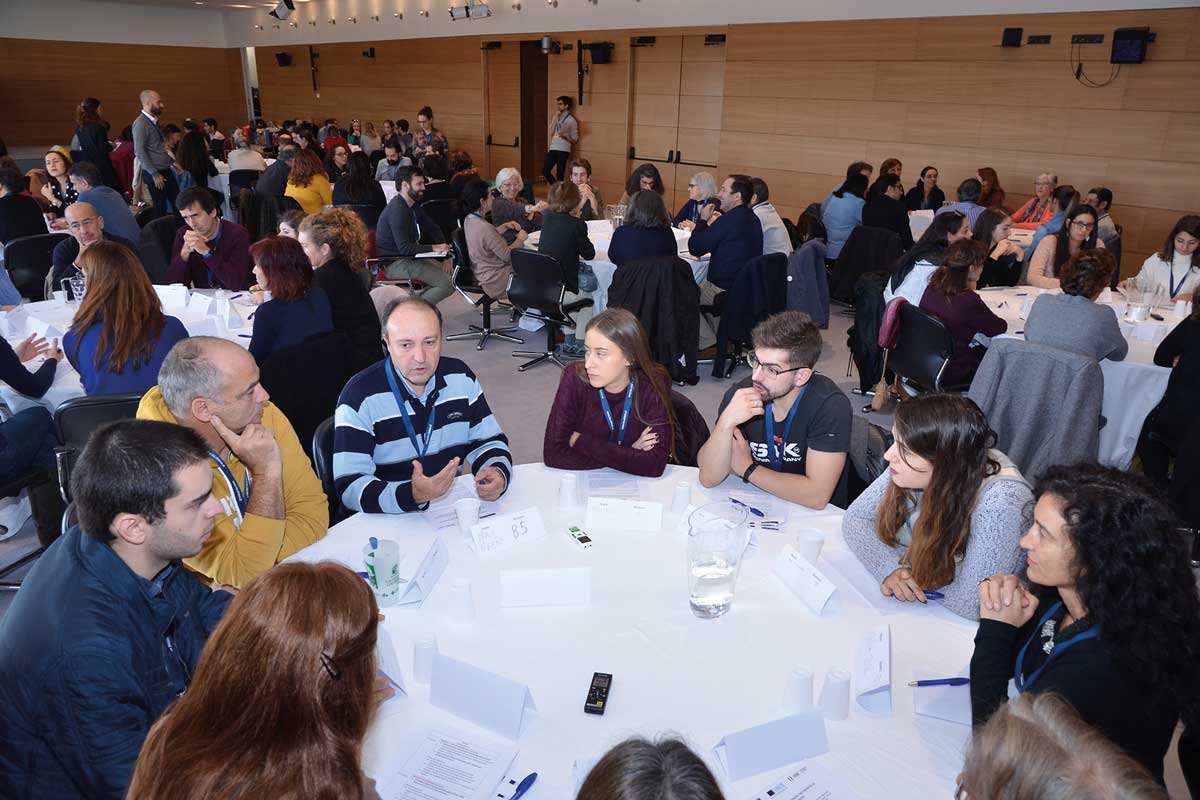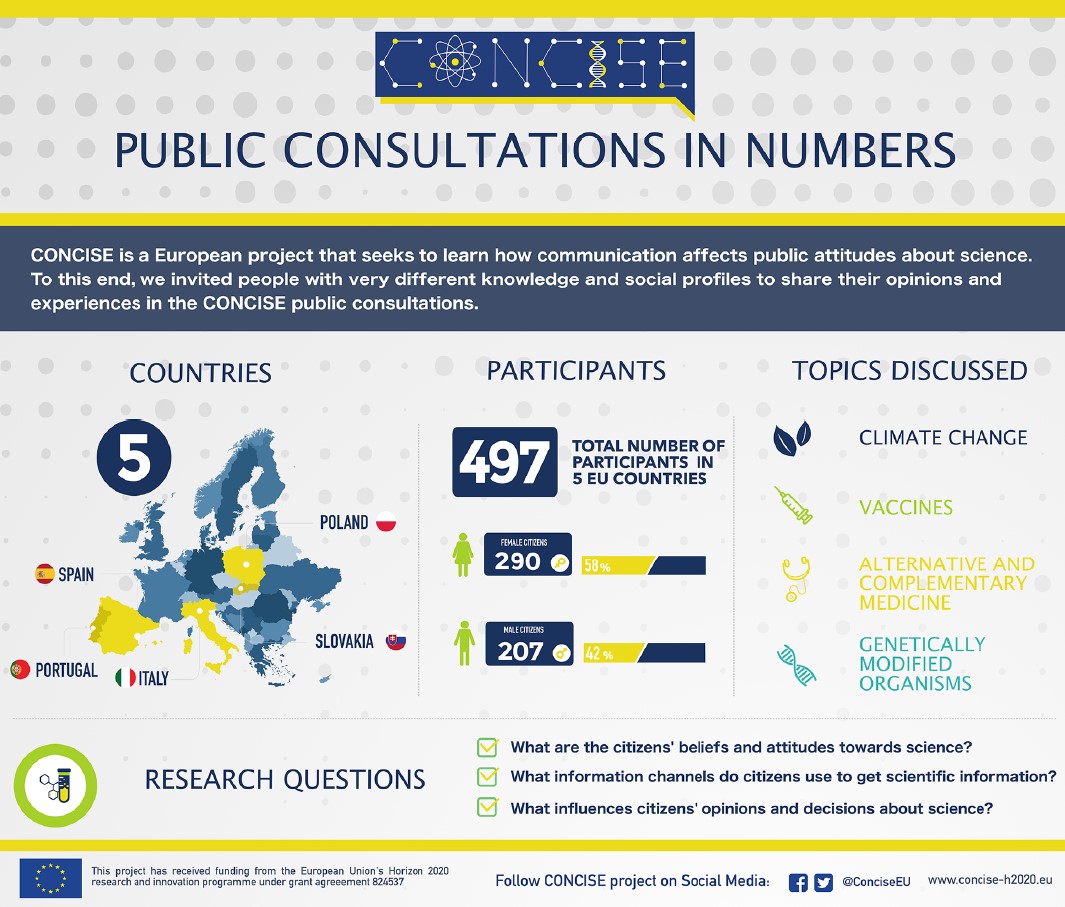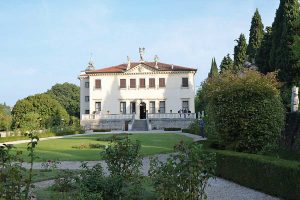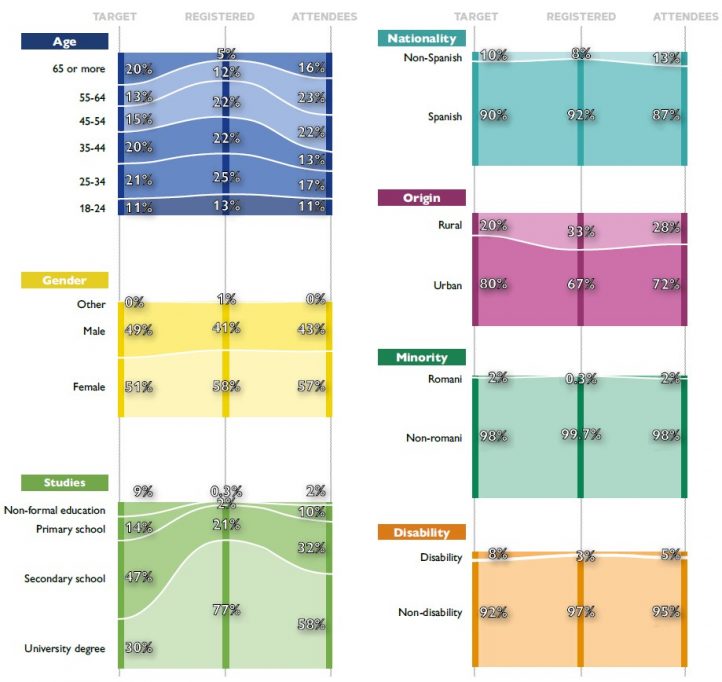
Citizen science is part of a wider trend in science and society of promoting two-way dialogue and engagement between scientists and the public, by involving citizens in the research process. This paper examines how CONCISE, an international research project involving Spain, Italy, Portugal, Poland, and Slovakia, seeks to understand how citizens acquire and use scientific information, by engaging citizens through public consultations. The consultations gathered close to 500 citizens in 2019. Asking them for suggestions on how to improve science communication and involving them in the dissemination efforts, CONCISE aims to put citizens at the core of the research process.
Keywords: Citizen consultations, science communication, science engagement, science publics, citizen participation.
Introduction
Citizen science is a prominent feature of current relations between science and society. Involving citizens in the production of science is seen as one of the best ways of generating understanding and trust and enhancing communication, but also to make science more attuned to citizens’ needs and concerns.
Like other domains, there are many ways of engaging citizens with science. The levels of engagement are varied, from asking citizens to collect data to involving them in all stages of the research project.
CONCISE is a European funded project that aims to understand how citizens acquire their science-related knowledge, and how this influences their beliefs, opinions, and perceptions. This paper aims to examine the ways in which citizen science has been framed and operationalised in the project.
Citizen science: A framework
The transition from a public understanding of science approach, based on a deficit model that attributed distrust of science to ignorance, to a public engagement with science approach is well documented (Bucchi & Neresini, 2008). Efforts to increase scientific literacy, by «teaching» science to the public, have been gradually (although not completely) replaced with initiatives that promote dialogue between the scientific community and the public and the participation of stakeholders and citizens in policy decisions alongside technical experts.
Citizen science is part of this transformation of science-society relations. The definition of what exactly constitutes citizen science is under dispute (Heigl et al., 2019). Different disciplinary and national traditions redound in different criteria for ascribing the citizen science label to projects. The White Paper on Citizen Science (Serrano-Sanz et al., 2014, p. 8) defined it as «the general public engagement in scientific research activities when citizens actively contribute to science either with their intellectual effort or surrounding knowledge or with their tools and resources». The European Citizen Science Association considers citizen science «a flexible concept which can be adapted and applied within diverse situations» and defined ten principles of citizen science, the first of which is: «citizen science projects actively involve citizens in scientific endeavours that generates new knowledge or understanding» (ECSA, 2015).
Other concepts have been proposed to define the same activities of involving citizens in scientific research, such as civic, civil, amateur, stakeholder, community or democratic science, science 2.0, knowledge co-production between lay people and experts, community-based participatory research, or public participation in scientific research (Bäckstrand, 2003; Bucchi & Neresini, 2008; Shirk et al., 2012).
«Efforts to increase scientific literacy, by “teaching” science to the public, have been gradually replaced with initiatives that promote dialogue between the scientific community and the public»
Three main strands in citizen science can be identified. The first strand concerns mainly the natural sciences, in particular the involvement of citizens in collecting or analysing data in astronomy, earth sciences, botany, and zoology projects (Brossard et al., 2005; Greenwood, 2007; Raddick et al., 2009). Similar practices are being used in other areas, such as biodiversity, genetics and agricultural sciences, engineering, or geography (Cooper et al., 2007; Ellis &Waterton, 2004).
Another strand of citizen science emerged from concerns with environmental contamination and its health effects in the 1970s, especially in the United States, which spurred the formation of community movements that pushed for more research along with new forms of community ownership over scientific evidence (Brown, 1997; Heinman, 1997). This has been labelled as popular or lay epidemiology, relying on «local» or «experiential» knowledge. It has expanded to several different contexts, such as water and air quality monitoring, investigation of the environmental causes of diseases, or other issues in sustainability science (Bäckstrand, 2003; Heinman, 1997).
A third tradition of citizen science can be found in the social sciences. Whereas participatory action research is considered a paramount methodology in this field (Reason & Bradbury, 2006), social scientists have contributed to a wide array of engaged action research in domains such as education, children studies, public health, urban planning, and international development (Gendron, 1998; Suarez-Balcazar et al., 2005). The role of social sciences has been mainly to pursue goals related to a more effective combination between expert and lay knowledge, as well as the empowerment of local communities.
Citizen science has become in recent years a quasi-autonomous scientific and practice field. It has its own associations or platforms at the international (the Citizen Science Association, the European Citizen Science Association) and national (e.g., the Australian Citizen Science Association) levels. In other cases, science communication associations included citizen science within their areas of activity (e.g., the British Science Association). There are conferences and publications solely devoted to the theme, such as Citizen Science: Theory and Practice. Several journals have published special issues dedicated to the topic of citizen science and the Web of Science contains over 3,000 articles about it. The EU-Citizen Science platform lists 110 ongoing citizen science projects. The Spanish Observatory of Citizen Science, run by the Ibercivis Foundation, has identified 236 citizen science initiatives in the country (including the CONCISE project).
«Citizen science is part of the transformation of science-society relations»
Citizen science projects can be classified according to the depth of citizen involvement. For instance, Cooper et al. (2007) proposed a typology of community projects with five types: scientific consulting research (science shops), citizen science research, adaptive citizen science research, adaptive co-management research, and participatory action research. Shirk et al. (2012) also defined five basic models for public participation in scientific research:
Contractual projects, where communities ask professional researchers to conduct a specific scientific investigation and report on the results; contributory projects, which are generally designed by scientists and for which members of the public primarily contribute data; collaborative projects, which are generally designed by scientists and for which members of the public contribute data but also help to refine project design, analyse data, and/or disseminate findings; co-created projects, which are designed by scientists and members of the public working together and for which at least some of the public participants are actively involved in most or all aspects of the research process; and collegial contributions, where non-credentialed individuals conduct research independently with varying degrees of expected recognition by institutionalized science and/or professionals. (Shirk et al., 2012: 29)
Most citizen science projects remain at the lowest level of citizen engagement: citizens are asked solely to collect data, while scientists carry out the analysis and interpretation, draw conclusions, and disseminate results. Citizens are thus ascribed a subordinate role, disregarding local and experiential knowledge, embodied skills, emotions, and ethical sensibilities or any contribution that goes beyond data collection within the restricted confines of instruments and protocols defined by scientists (Cornwell & Campbell, 2012). Ellis and Waterton (2004) point out the paradox of involving citizens because expert contributions are insufficient for supporting robust policies and then limiting their involvement by curbing the expression of alternative knowledge and cultural epistemologies and ontologies.

Figure 1. The CONCISE project developed its own public consultation methodology. The consultations were designed to involve one hundred citizens in each country and to bring them all together for a one-day discussion on science communication. Citizens were divided into groups of eight or ten people and allocated to a table, together with a moderator and an observer. The discussion focused on four socially sensitive scientific topics: climate change, vaccines, GMOs, and alternative medicine, and alternative and complementary medicine. / Source: FyG and AECC
The CONCISE project
CONCISE, Communication role on perception and beliefs of European Union Citizens about Science, is a research project funded by the European Commission through its Horizon 2020 programme. It is led by the University of Valencia and has the participation of four other universities across Europe (Pompeu Fabra University, Trnava University, University of Łódź, and the University of Lisbon, through the Institute of Social Sciences), two non-government organizations (Observa and the Spanish Association of Science Communication) and two small and medium enterprises (Danmar Computers and FyG Consultores). Therefore, the project involves five countries: Spain, Portugal, Italy, Slovakia, and Poland.
«Citizen science has become in recent years a quasi-autonomous scientific and practice field»
CONCISE’s main objective is to learn the role science communication plays on the origin of beliefs, perceptions, and knowledge concerning scientific issues. In this way, investigates the means or channels by which EU citizens acquire their science-related knowledge, and how this knowledge influences their beliefs, opinions, and perceptions. Furthermore, the project intends to generate a European-wide debate on science communication, involving a wide array of stakeholders, from media outlets to policy makers, from scientists to business companies, from science communicators to civil society organisations. Last but not least, CONCISE strives to enable active citizen participation in scientific research processes, in line with the concept of responsible research and innovation (RRI).
The core methodological procedure of the research are public consultations with citizens of the five participating countries. It is through these consultations that citizens are engaged in the scientific process, contributing to the production of science by sharing their opinions, perceptions, and suggestions to improve science communication.
The citizen consultations
The methodological option for citizen consultations, in lieu of the more customary surveys or interviews, is due to the depth of information that can be collected through this procedure. Discussions among citizens allow us to better understand the divergence of opinions and capture the narratives and processes through which citizens build and justify their attitudes and beliefs in science. It also generates a participatory dynamic that engages citizens in the research process, rather than just collecting information from them.
Based on available literature on participatory methods (see, for instance, the action catalogue developed in the European project Engage 2020), CONCISE developed its own methodology of public consultation. This methodology was tested in a pilot consultation in Barcelona in March 2019, before being improved and applied in all five participating countries between September and November 2019 (Figure 1).

Figure 2. In most cases, the locations chosen for the consultation were also meant to convey a sense of neutrality in terms of scientific authority. In the picture, Villa Valmarana ai Nani, Vicenza, the location of the Italian CONCISE consultation. / Photo: Danmar
The consultations were designed to involve one hundred citizens in each country and to bring them all together for a one-day discussion on science communication. Citizens were divided into groups of eight or ten people and allocated to a table, together with a moderator and an observer, who took notes. The discussion was divided into four sessions, each addressing a controversial scientific topic: climate change, vaccines, genetically modified organisms (GMO), and alternative and complementary medicines. No information on the topics was provided to the citizens beforehand nor during the consultations.
In most cases, the locations chosen for the consultation were also meant to convey a sense of neutrality in terms of scientific authority: an 18th century palazzo in Italy, a botanical garden in Spain, or a cultural centre in Portugal (Figure 2).
The sample of one hundred citizens in each country was not meant to be representative of the population of the countries (see Figure 3 for the Spanish sample example) but rather to be diversified in terms of gender, age, educational level, occupation, and region. It was also meant to be inclusive in terms of nationality, migrant backgrounds, and physical disabilities. While the results cannot be extrapolated to the entire population, they show, however, a wide variety of opinions and perceptions over the four topics. Including opinions from diverse social groups is fundamental for enriching public debates. This includes citizen science and its democratization by reaching out to wider audiences. In fact, studies have revealed that volunteers for citizen science projects are mostly male, highly educated and show favourable attitudes towards science before their participation (Curtis, 2018; Haklay, 2018). However, that was not exactly the case in the CONCISE project, where women were engaged more easily (Figure 1). Through the selection of participants after registration, we were able to ensure a greater diversity of participants (Figure 3).
The distribution of citizens by tables was done according to their educational levels. We wanted to create the conditions for the free expression of opinions, without arguments of authority that can emerge in groups where some participants have higher levels of educational attainment. Contrariwise, the tables were heterogeneous in terms of gender and age, to create a more lively and diversified discussion (Figure 4).
«Discussions generate a participatory dynamic that engages citizens in the research process, rather than just collecting information from them»
The discussion at the tables was steered by the moderators following a script designed to address the research questions of the project. For each scientific topic, citizens were asked how they obtained scientific information, how they assessed the reliability of information and sources and whether they performed active searches, and how they would like to receive scientific information. These discussions were audio recorded and transcribed verbatim. After each round of discussions, participants were also asked to take part in a quantitative activity: a short survey on the topic of the discussion in two cases, two questions on general attitudes towards science in another case, and an assessment of online media headlines on the fourth.
The data collected has not only allowed to understand how citizens perceive and assess scientific information but also garner their suggestions on how to improve science communication and the presentation of scientific knowledge. The analysis aims at identifying shared ideas by participants in all the citizen consultations about four aspects: message (language, formats); medium (digital media, educational system, traditional media); producers (institutions, scientists, teachers, journalists, science communicators) and target audiences (children, general public, elderly, professionals). The qualitative analysis of the content has allowed not only to assess individual perceptions and attitudes (and by gender, age groups, educational level), but also the groups discussions and the interactions between participants.
It is this information provided by citizens that has informed our analysis of the phenomenon and our policy recommendations (Moreno-Castro et al., 2020). Since participants were also asked to give their feedback on the consultation itself, through a questionnaire at the end of the events, their opinions will also help improve the methodology and design more effective ways of engaging citizens in scientific research.

Figure 3. Each graphs represents the target percentages to mirror the Spanish population, the citizens registered at a first stage before any selection was made, and percentage of citizens who finally attended the citizen consultation, for each of the diversity characteristics considered in the sample. Note: Any imbalance in the percentage sum is due to the rounding off. / Source: CONCISE
Next steps in involving the public
Involving citizens in data collection is the most frequent practice in citizen science, as seen above. CONCISE can be thus considered a contributory project, according to the typology mentioned above. But citizens can and should also participate in other stages of the project, namely to be informed of the results and collaborate in dissemination as well.
The CONCISE team has already produced two kinds of dissemination materials about the process of the consultations aimed at the general public: infographics (Figure 1) and videos (containing footage of the events and interviews with participants and organisers). The videos were sent to the citizens who participated in the consultations and they, in turn, shared them with their contacts.
Once the data analysis is concluded, the CONCISE team is developing different dissemination materials tailored to different audiences: scientific articles for researchers, policy briefs for policy-makers (Moreno-Castro et al., 2020), press releases for media outlets. In all outputs, the collaboration of the citizens is acknowledged. However, it will also be important to design dissemination materials accessible to a wider audience, including the consultation participants. These materials can be research briefs written in a non-hermetic language, infographics that are clear and easy to understand, videos showcasing the most relevant outcomes of the project.
Citizens will play an important role in the diffusion of the results among their social networks of friends and relatives. The results show ways to fight disinformation, to dismiss fake news and hoaxes, to develop strategies to identify trustful sources of scientific information and base everyday decisions and behaviours on them. And who better to benefit from this information than the general public? Although we intend to issue recommendations to scientists, communicators, and policymakers, it is the public who is the true recipient of our research endeavours.
References
Bäckstrand, K. (2003). Civic science for sustainability: Reframing the role of experts, policy-makers and citizens in environmental fovernance. Global Environmental Politics, 3(4), 24-41. https://doi.org/10.1162/152638003322757916
Brossard, D., Lewenstein, B., & Bonney, R. (2005). Scientific knowledge and attitude change: The impact of a citizen science project. International Journal of Science Education, 27(9), 1099–1121. https://doi.org/
10.1080/09500690500069483
Brown, P. (1997). Popular epidemiology revisited. Current Sociology, 45(3), 137-156. https://doi.org/10.1177/001139297045003008
Bucchi, M., & Neresini, F. (2008) Science and public participation. En E. J. Hackett et al., Handbook of science and technology studies (pp. 449–472). MIT Press.
Cooper, C. B., Dickinson, J., Phillips, T., & Bonney, R. (2007). Citizen science as a tool for conservation in residential ecosystems. Ecology and Society, 12(2), 11.
Cornwell, M. L., & Campbell, L. M. (2012). Co-producing conservation and knowledge: Citizen-based sea turtle monitoring in North Carolina, USA. Social Studies of Science, 42(1), 101–120. https://doi.org/10.1177/0306312711430440
Curtis, V. (2018). Online citizen science and the widening of academia. Palgrave Macmillan.
ECSA. (2015). ECSA 10 principles of citizen science. https://eu-citizen.science/resource/88
Ellis, R., & Waterton, C. (2004). Environmental citizenship in the making: The participation of volunteer naturalists in UK biological recording and biodiversity policy. Science and Public Policy, 31(2), 95–105. https://doi.org/10.3152/147154304781780055
Gendron, S. (1998). La recherche participative: Un cas d’illustration et quelques réflexions pour la santé publique. Ruptures, revue transdisciplinaire en santé, 5(2), 180–191.
Greenwood, J. J. D. (2007). Citizens, science and bird conservation. Journal of Ornithology, 148, 77–124. https://doi.org/10.1007/s10336-007-0239-9
Haklay, M. (2018). Participatory citizen science. In S. Hecker, M. Haklay, A. Bowser, Z. Makuch, J. Vogel, & A. Bonn (Eds.), Citizen science: Innovation in open science, society and policy (pp. 52–62). UCL Press. https://doi.org/10.14324/111.9781787352339
Heigl, F., Kieslinger, B., Paul, K. T., Uhlik, J., & Dörler, D. (2019). Opinion: Toward an international definition of citizen science. Proceedings of the National Academy of Sciences, 116(17), 8089–8092. https://doi.org/10.1073/pnas.1903393116
Heinman, M. K. (1997). Science by the people: Grassroots environmental monitoring and the debate over scientific expertise. Journal of Planning Education and Research, 16(4), 291–299.
Moreno-Castro, C. Mendoza, I., Delicado, A., Rowland, J., Estevens, J., Pellegrini, G., Brondi, S., Rubin, A., Fattori, S., Llorente, C., Warwas, I., Krzewińska, A., Dzimińska, M., Guran, P., Miháliková, S., Fero, M., Šottnik, L., Hrnčiarik, E., Gaston, E., Staszynska, A., Ciąpała, K. (2020). Communication role on perception and beliefs of EU citizens about science. Policy brief 2020. Recomendations for European policy-makers and communicators. https://concise-h2020.eu/wp-content/uploads/2020/12/CONCISE_policy_brief_EN.pdf
Raddick, M. J., Bracey, G., Carney, K., & Gyuk, G. (2009). Citizen science: Status and research directions for the coming decade. Astro2010: The Astronomy and Astrophysics Decadal Survey, Position Papers, no. 46. http://www8.nationalacademies.org/astro2010/DetailFileDisplay.aspx?id=454
Reason P., & Bradbury H. (Eds.). Handbook of action research: Participative inquiry and practice. Sage.
Shirk, J. L., Ballard, H. L., Wilderman, C. C., Phillips, T., Wiggins, A., Jordan, R., McCallie, E., Minarchek, M., Lewenstein, B. V., Krasny, M. E., & Bonney, R. (2012). Public participation in scientific research: A framework for deliberate design. Ecology and Society, 17(2), 29.
Serrano-Sanz, F., Holocher-Ertl, T., Kieslinger, B., Sanz García, F., & Silva, C. G. (2014). White paper on citizen science for Europe. https://ec.europa.eu/futurium/en/system/files/ged/socientize_white_paper_on_citizen_science.pdf
Suarez-Balcazar, Y., Harper, G. W., & Lewis, R. (2005). An interactive and contextual model of community-university collaborations for research and action. Health Education & Behavior, 32(1), 84–101. https://doi.org/10.1177/1090198104269512
Acknowledgements
This project has received funding from the European Union’s Horizon 2020 research and innovation programme under grant agreement No. 824537.





